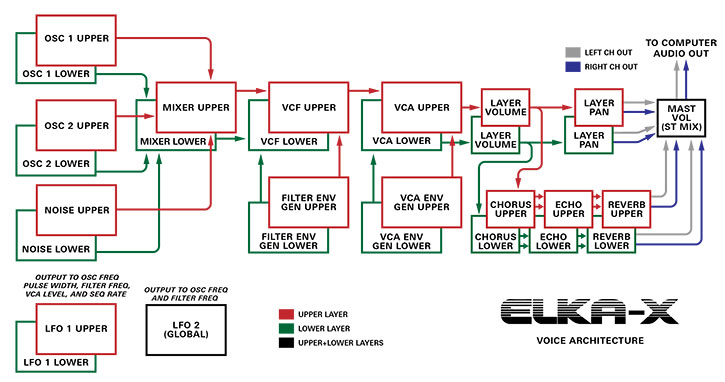
Elka-X's overall layout should be familiar to anyone experienced with classic mono and poly synths. The signal path begins in the center of the instrument with two near-identical digitally-controlled oscillators, each with selectable range and triangle, saw, square, and variable-pulse waveforms. Each oscillator also allows pulse-wave cross modulation in addition to ring modulation. Oscillator 1 includes an oscillator sync button, and oscillator 2 includes a Detune fine-tune control. Each oscillator includes a volume control.
A white/pink noise generator with a volume control. The oscillators and noise generator are summed, and routed to a multimode filter voltage-controlled filter (VCF), which affects the sound timbre. From the VCF, the signal travels to the voltage-controlled amplifier (VCA) for amplitude shaping via the VCA ADSR envelope generator. The VCF also has its own ADSR envelope generator for dynamic filter tone shaping.
The signal is tapped following the Layer Volume control (before to the Layer Pan control) and sent in parallel to the Chorus, Echo, and Reverb effects and mixed with the dry final output signal. All effects are stereo.
Elka-X can operate as a standard "single layer" polysynth with up to 16 voices (in Single keyboard mode), or in Double (stacked) or Split (separate sounds assigned above and below a user-specified split point) mode with completely independent sounds and signal paths for the upper (red in the diagram) and lower layers (green in the diagram). Onboard effects are also fully independent for the the upper and lower layers.
Elka-X also includes two independent modulation sections, a fixed LFO 1 section, and performance-oriented LFO 2 section, intended for use with pitch and mod wheel controllers.
Though not shown in the diagram, Elka-X also includes a sequencer with four monophonic sequences per patch, assignable to the upper or lower layer. Each sequence can be up to 128 steps in length.